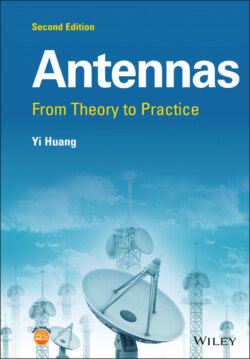Читать книгу Antennas - Yi Huang - Страница 15
1.2 Radio Systems and Antennas
ОглавлениеA radio system is generally considered as an electronic system that employs radio waves, a type of EM wave up to GHz frequencies. An antenna, as an essential part of a radio system, is defined as a device that can radiate and receive EM energy in an efficient and desired manner. It is normally made of metal, but other materials may also be used. For example, ceramic materials have been employed to make dielectric resonator antennas (DRAs). There are many things in our lives, such as a power leads that can radiate and receive EM energy but cannot be viewed as antennas because the EM energy is not transmitted or received in an efficient and desired manner or because they are not a part of a radio system, thus they cannot be called antennas.
Since radio systems possess some unique and attractive advantages over wired systems, numerous radio systems have been developed. TV, radar, and mobile radio communication systems are just some examples. The advantages include at least:
Mobility: it is essential for mobile communications;
Good coverage: the radiation from an antenna can cover a very large area that is good for TV and radio broadcasting and mobile communications;
Low pathloss: this is distance (and frequency) dependent. Since the loss of a transmission line is an exponential function of the distance (the loss in dB = distance × per unit loss in dB) and the loss of a radio wave is proportional to the distance square (the loss in dB = 20 log10 (distance)), thus the pathloss of radio waves can be much smaller than that of a cable link. For example, assume that the loss is 10 dB for both a transmission line and a radio wave over 100 m, if the distance is increased 10 times to 1000 m, the loss for the transmission line becomes 10 × 10 = 100 dB but the loss for the radio link is just 10 + 20 = 30 dB, which is much smaller than 100 dB! Therefore, the radio communication system is extremely attractive for long‐distance communication. It should be pointed out that optic fibers are also employed for long‐distance communications since they are of very low loss and UWB – but it is for point‐to‐point communications and fibers/cables normally need to be buried in subsurface, which could be costly in practice.
Figure 1.5 illustrates a typical radio communication system. The source information is normally modulated and amplified in the transmitter and then passed on to the transmit antenna via a transmission line, which has a typical characteristic impedance (which will be explained in the Chapter 2) of 50 Ω. The antenna radiates the information in the form of an EM wave in an efficient and desired manner to the destination, where the information is picked up by the receiver antenna and passed on to the receiver via another transmission line. The signal is demodulated, and the original message is then recovered at the receiver.
Figure 1.5 A typical radio system
Thus, the antenna is actually a transformer that transfers electrical signals (voltages and currents from a transmission line) into EM waves (electric and magnetic fields) or vice versa. For example, a satellite dish antenna receives the radio wave from a satellite and transfers it into electrical signals which are output to a cable to be further processed. Our eyes may be viewed as another example of antennas. In this case, the wave is not a radio wave but an optical wave, another form of EM wave that has much higher frequencies.
Now it is clear that the antenna is actually a transformer of voltage/current to electric/magnetic field; it can also be considered as a bridge to link the radio wave and transmission line. An antenna system is defined as the combination of the antenna and its feed line. As an antenna is usually connected to a transmission line, how to make this connection is a subject of interest since the signal from the feed line should be radiated into the space in an efficient and desired way. Transmission lines and radio waves are in fact two different subjects in engineering. To understand the antenna theory, one has to understand transmission lines and radio waves, which will be discussed in detail in Chapters 2 and 3, respectively. Thus, there is no need for the reader to study these subjects using other books.
In some applications where space is very limited (such as hand portables and aircrafts), it is desirable to integrate the antenna and its feed line. In other applications (such as the reception of TV broadcasting), the antenna is far away from the receiver and a long transmission line has to be used.
Unlike other devices in a radio system (such as filters and amplifiers), the antenna is a very special device; it deals with electrical signals (voltages and currents) as well as EM waves (electric fields and magnetic fields) that have made antenna design an interesting and difficult subject. For different applications, the requirements on the antenna could be very different, even for the same frequency band.
In conclusion, the subject of antennas is about how to design a suitable device that will be well matched with its feed line and radiate/receive the radio wave in an efficient and desired manner.
